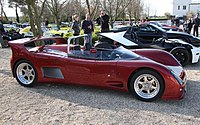Ultima Sport
| Ultima Sport | |
|---|---|
 | |
| Overview | |
| Manufacturer | Ultima Sports Ltd |
| Also called | Ultima Spyder |
| Production | 1992-1999 |
| Designer | Lee Noble and Ted Marlow[1] |
| Body and chassis | |
| Class | Sports car (S) |
| Body style | 2-door coupé 2-door roadster |
| Layout | Rear mid-engine, rear-wheel drive |
| Doors | Butterfly |
| Powertrain | |
| Engine | |
| Dimensions | |
| Kerb weight | 850–990 kg (1,874–2,183 lb) |
| Chronology | |
| Predecessor | Ultima Mk3 |
| Successor | Ultima GTR |
Ultima Sport and Ultima Spyder is a supercar built by (then) kit-car manufacturers Ultima Sports Ltd. They are of a can-am design, with GRP bodywork set atop a bespoke chassis meant to accommodate a variety of engines from four to eight cylinders, or rotaries.[2] The design is of a mid-engined, rear wheel drive layout, with a tubular steel space frame chassis.[3] Originally meant as a kit car, Ultima began producing its first turn-key examples during the production run of the Sports/Spyder (the first such car being completed in 1993).
History[edit]
The Ultima Sport and its roadster derivative, the Ultima Spyder, were built from 1992 to 1999. The body styles were carried over largely unchanged for the succeeding Ultima GTR and Ultima Can-Am (roadster) models. The Sport, sometimes referred to as the Mk4 in company literature, followed on the Mk1 (1983), the Mk2 (1984), and the Mk3 (1989). The Mk2 was based on the Mk1 but with new suspension and better brakes, while the Mk3 received a new body.[4] Ted Marlow and Richard Marlow bought the rights to the car in 1992 and started building a revised model called the Ultima Sport.[4] The earlier Mk3 had been used by McLaren in testing their upcoming F1 supercar; one to test the gearbox and central seating position ("Albert", chassis number 12) and the other car to test the BMW V12 engine and ancillaries ("Edward", number 13).[5] This was frequently mentioned in Ultima's company literature and period reviews.[2]
The Ultima Sport used a developed version of the Mk3 bodywork, with larger headlamp openings which held three lights rather than the single units of the Mk3. A large rear spoiler, incorporated into the rear bodywork, became an available option in 1993, while power assisted brakes only became available in 1997.[3] The Spyder was new; this roadster variant offered a cut-down windshield and minimal protection from the elements. Originally introduced in 1993, it was first intended as a lower-cost example and Ultima expected buyers to opt for the Rover V8 and a Renault transaxle; customer demand, however, meant that Chevrolet small-block V8s were typically fitted instead. While a variety of engines could be fitted, in latter years Chevrolet's 5.7-litre small-block V8 became dominant. For buyers of the fully built-up models, the choice of engine was restricted to this engine, in three grades of performance with either 345, 430, or 500 hp (254, 316, or 368 kW) depending on the state of tune.[3]
-
Rear view; this was squared off for the succeeding GTR to provide more downforce
-
The Ultima Spyder was the roadster version, with a cut down windshield and a minimum of creature comforts
References[edit]
- ^ Webster, Larry (April 2000). "Ultima GTR". Car and Driver. Retrieved 17 April 2014.
- ^ a b Ultima Sport & Spyder - Mean & Roofless (sales sheet), Cloverfield, Hinckley, Leicester, UK: Ultima Sports Ltd., c. 1996
- ^ a b c Münzenmayer, Ralph (September 1997). "Ultimaaaaa!". Playboy Netherlands (in Dutch). p. 43.
- ^ a b "1983-1991". Ultima Sports Ltd. Retrieved 5 April 2018.
- ^ Prior, Matt (20 February 2015). "Matt Prior's tester's notes - how to hide your test car, the McLaren way". Autocar. Haymarket Media Group. Archived from the original on 5 December 2021.


